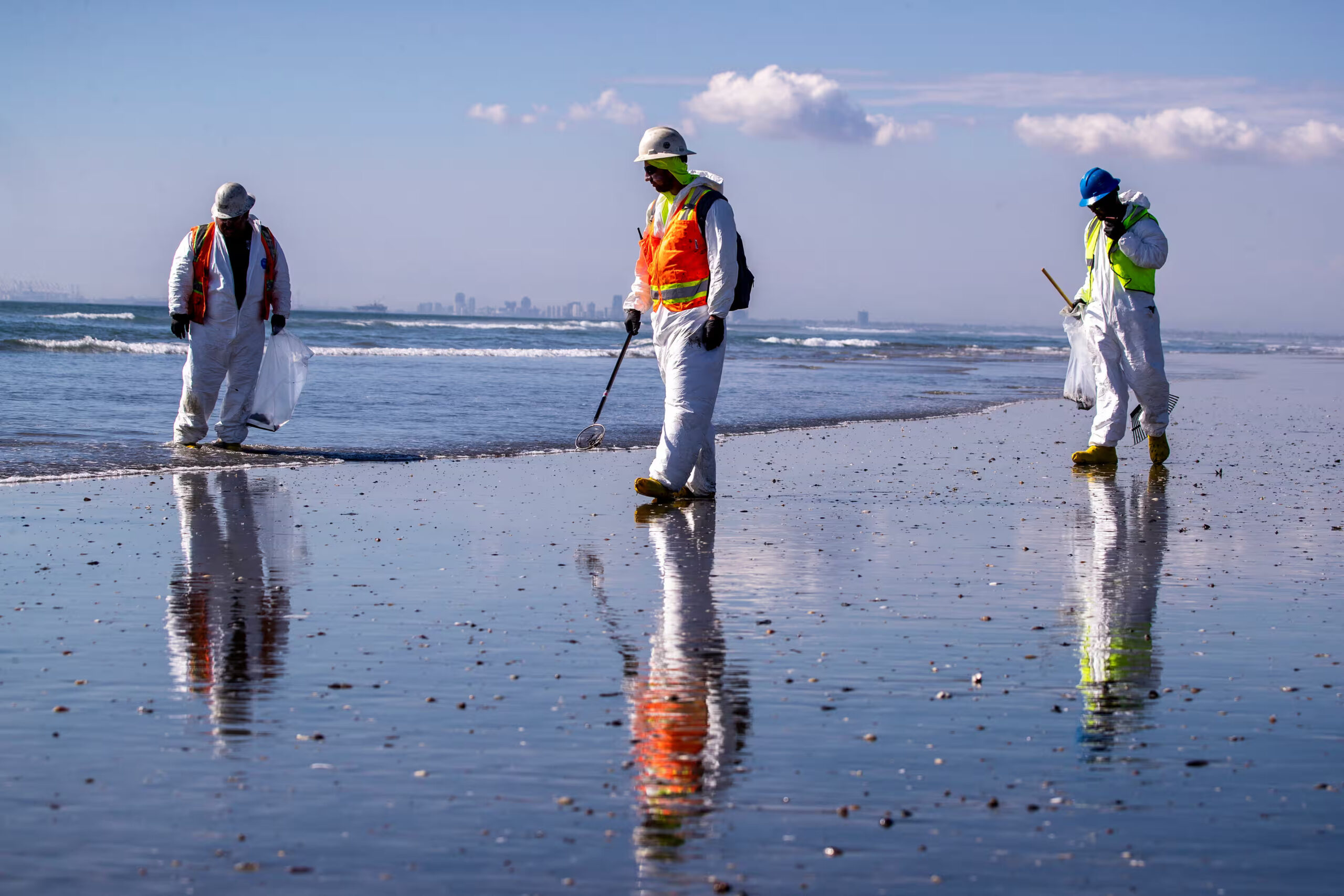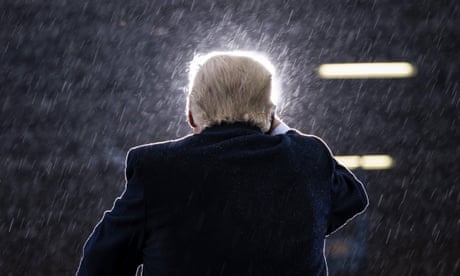 Environmental oil spill cleanup crews clean oil chunks off the beach from a major spill in Huntington Beach, California, in October 2021. Photograph: Allen J Schaben/Los Angeles Times via Getty Images –
Environmental oil spill cleanup crews clean oil chunks off the beach from a major spill in Huntington Beach, California, in October 2021. Photograph: Allen J Schaben/Los Angeles Times via Getty Images –
Trump has made campaign promises to toss crucial environmental regulations – including dismantling the federal body with the most power to tackle the climate crisis
Supported by
–
Donald Trump and his advisers have made campaign promises to toss crucial environmental regulations and boost the planet-heating fossil fuel sector.
Those plans include systemically dismantling the Environmental Protection Agency (EPA), the federal body with the most power to take on the climate emergency and environmental justice, an array of Trump advisers and allies said. It’s a potential future that “horrifies” experts.
“I think it would be devastating,” said Michael Gerrard, director of the Sabin Center for Climate Change Law at Columbia Law School.
During his first White House stint, Trump successfully proposed cutting the EPA budget. Hundreds of scientists and other experts fled the agency as the administration dismissed scientific findings and weakened environmental regulations.
The attacks on the agency could become even harsher during a second Trump term, experts and insiders say.
“They’re going to be better prepared to do things that really make a difference,” said Jeff Holmstead, who ran the EPA’s air office during the Bush administration.
Trump’s first term was marked by ethics violations and scandals – something Holmstead attributed to a lack of experience. This time around, Trump officials have more detailed plans, including a lengthy proposal to gut regulatory agencies, which Gerrard said would have cascading effects.
“You’d see a brain drain as fewer young people will want to work there,” he said. “We would see a lot more effort on all things fossil fuels, and already the prospect of a second Trump administration is making clean energy investors nervous.”
In an interview with the Guardian, Mandy Gunasekara, Trump’s EPA chief of staff, criticized Biden’s EPA for perceived overreach. “This administration has in many ways used EPA as a tool to make it harder for the particular type of industries and technologies they do not like to operate,” she said. “Exhibit A is their disdain for fossil fuels.”
In Project 2025, a presidential agenda put forth by the Heritage Foundation and other conservative organizations, Gunasekara outlined ways to shrink the agency and move it away from its focus on the climate crisis.
A second Trump EPA, said Gunasekara, would foster closer relationships with the fossil fuel industry – a sector scientists say must be phased out to avert climate catastrophe – and cut programs focused on justice and outreach that are not “part of the core function or don’t deliver on the core mission”.
That means shuttering the Environmental Justice and Civil Rights office, which Biden launched last year. Gunasekara described the office as a “political arm of EPA” that does not deliver tangible benefits. The offices of Public Engagement and Environmental Education, as well as the International and Tribal Affairs, which she said could be replaced with the narrower Office of the American Indian, would also be among the first to go. Closing these offices would amount to “tyranny”, said María López-Núñez, deputy director at Newark, New Jersey’s Ironbound Community Corporation, a grassroots environmental organization. “We on the frontlines don’t often have the political power to make agencies remember us.”
The EPA’s public engagement and justice-focused offices, she said, are some of the most important resources for grassroots organizers looking to keep their communities safe from pollution.
The Biden administration has made strides to promote environmental justice, including mandating that 40% of the benefits of certain investments flow to disadvantaged communities.
“I wish it had gone further, but it did at least make visible the fact that frontline communities have a disproportionate amount of pollution [but] don’t receive that same proportion of funding,” López-Núñez said. That program would probably disappear under a second Trump administration.
Through the 2021 Infrastructure Investment and Jobs Act and 2022 Inflation Reduction Act (IRA), the Biden administration has allocated billions of dollars in grants over the coming years for communities hit hard by pollution and climate threats.
But if elected, Gunasekara said Trump should work with Congress to roll back those grant programs. “A lot of the IRA was just taking massive buckets of taxpayer dollars and gifting them to EPA with very little oversight,” she said.
A second Trump administration would also pull back EPA regulations. A 2023 proposal to tighten carbon pollution standards for US coal and gas-fired power plants would be revisited, Trump’s allies say. So would a 2023 proposal from the EPA and the National Highway Traffic Safety Administration to increase the fuel efficiency requirements for new vehicles, known as Corporate Average Fuel Economy (CAFE) standards.
The latter rule has become a prime target for Trump, who has also attacked electric car subsidies from the Inflation Reduction Act and repeatedly vowed to repeal Biden’s “insane electric vehicle mandate”.
“EVs have a place in the market but they aren’t going to replace conventional vehicles for a lot of purposes,” said Myron Ebell, who headed up the EPA transition team ahead of Trump’s first term. He said the Trump administration should not only reject Biden’s proposed strengthening of CAFE standards but also loosen the existing standard.
A more conservative Supreme Court, which has already whittled away some of the EPA’s ability to tackle water pollution and emissions from power plants, will also help “push back against regulatory excess”, said Tom Pyle, the head of the transition team for the US Department of Energy for Trump’s first term.
“But we are not entirely done,” he said. “The EV mandate needs to be completely revoked and the CAFE standards should be stayed and revisited. This administration is moving far too quickly than people are comfortable with with this technology.”
Another change Gunasekara proposed: closing the EPA’s Office of Enforcement and Compliance Assurance and instead letting individual program offices, such as the air program and the water program, handle their own enforcement. It would be a way to counter the “unnecessary tension between the regulator and the regulated”, Gunasekara said.
In practice, experts say this would lead to far less aggressive enforcement of pollution controls.
“When I think about the EPA … getting cozy with industry, it horrifies me because I think about how much death there will be as a byproduct,” said López-Núñez.
López-Núñez has long criticized Biden’s EPA for not doing enough for communities most impacted by pollution and the climate crisis.
“But at least we’ve been able to have dialogue with [the] EPA,” she said. “Under Trump there [would be] no more of that.”
–






















